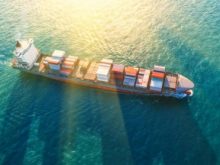 Shipping accounts for two to three per cent of global greenhouse gas emissions so manufacturers and retailers are no longer just considering what appears in national targets. Even though individual governments are not on the hook for these supply chain emissions, some of Australia’s largest companies are getting ready.
Shipping accounts for two to three per cent of global greenhouse gas emissions so manufacturers and retailers are no longer just considering what appears in national targets. Even though individual governments are not on the hook for these supply chain emissions, some of Australia’s largest companies are getting ready.
BHP is the world’s largest charterer of ships, which means marine emissions are a problem for future profits and reputation. Rio Tinto is in the same boat as iron ore makes up a third of Australian exports. They have lined up a small number of LNG-fuelled bulk carriers as an immediate solution to lower emissions.
Some say green ammonia made with hydrogen, using a water electrolysis process powered by solar and wind energy, could become the marine fuel of choice one day. Nuclear power could also be a clean but more expensive and currently illegal source of electricity for producing hydrogen and ammonia through electrolysis.
Australia will still be shipping almost $100 billion a year in coal and gas by 2050, according to federal government modelling.
Breaking News
- ‘Tech-driven, solutions-oriented mindset makes the sector an exciting frontier’
- ‘Use innovation to solve inefficiency, modernise processes’
- Qatar Airways Cargo, Skyways team up to boost digital efficiency
- ‘Redesigning logistics around speed, sustainability & smart tech’
- ‘Innovation is fuelled by education emphasizing data science, automation & sustainable practices’
- PHDCCI to host Gati Se Pragati Conclave 2025
- GEODIS launches AirSmart to enhance sustainable ops
- Global air cargo demand rises by 6% in May: WorldACD
- Nifty India Infra & Logistics Index launched to record logistics performance
- Shree Cement, RITES sign MoU to boost rail infrastructure network
- Ekart joins ONDC Network to enhance logistics infrastructure
 Cargo Breaking News
Cargo Breaking News


